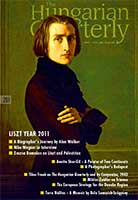Liszt and Palestrina
Liszt and Palestrina
Author(s): Zsuzsanna DomokosSubject(s): Music
Published by: Society of the Hungarian Quarterly
Summary/Abstract: Palestrina and the “Palestrina style” as interpreted in the 19th-century The term “Palestrina style” had several different meanings in the 19th century, yet those meanings (referring to the works of Palestrina himself; the a cappella works of his contemporaries and the generation following him; strict style in general) were often blurred in actual practice. In Italy, the expression alla Palestrina designated the musical language of Palestrina and the Roman school of the 16th and 17th centuries, as represented by Felice and Giovanni Francesco Anerio, Francesco Soriano and Gregorio Allegri (who was the most famous of them all in the 19th century); it could also be used as a synonym of stile antico. “Palestrina style” could further refer to an abstract concept; the glorification of Renaissance music, with Palestrina as its emblem, implied a strong contrast with more recent musical styles. References to Palestrina by Liszt and his contemporaries reflect not only the influence of any Palestrina works that were known to them, but encompass the entire a cappella literature of the 16th and 17th centuries. In particular, Liszt often mentions Orlande de Lassus alongside Palestrina. Unlike most German contemporaries, however, Liszt did not typically use “Palestrina style” as a term for strict polyphonic writing in general.
Journal: The Hungarian Quarterly
- Issue Year: 2011
- Issue No: 201
- Page Range: 75-86
- Page Count: 12
- Language: English

